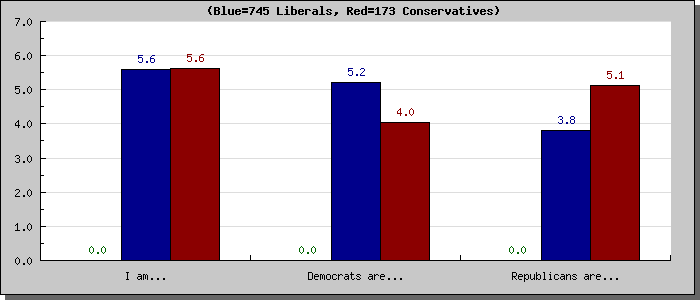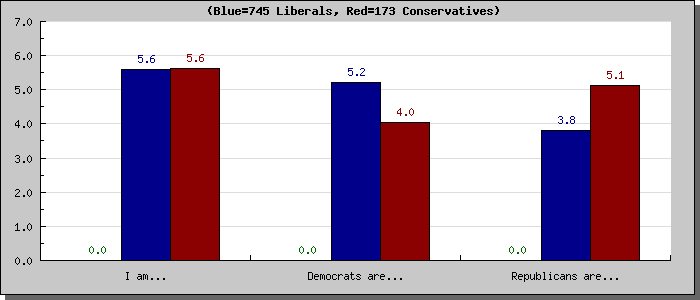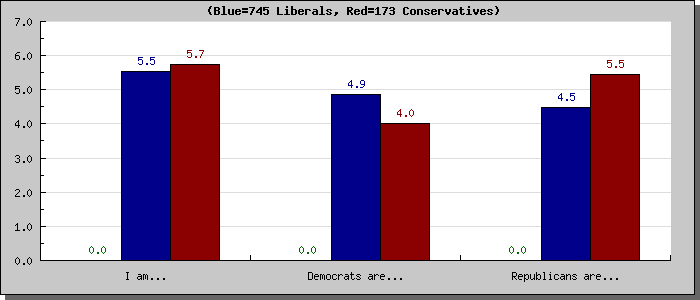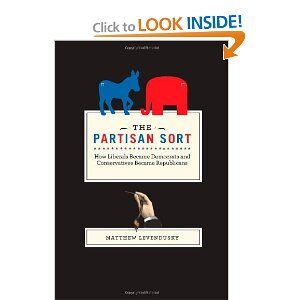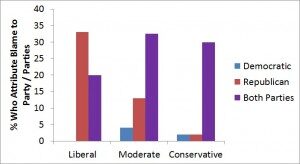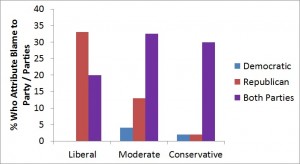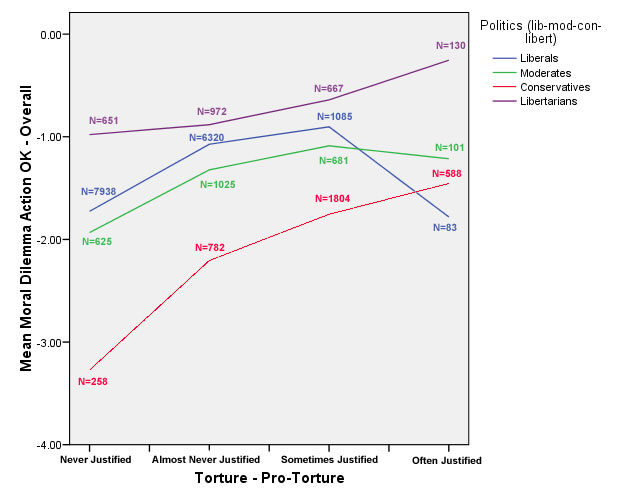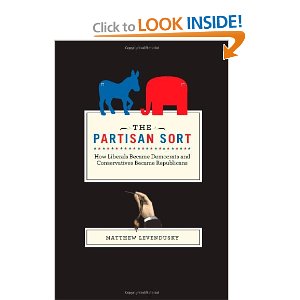
Book Review
For much of America’s history, political parties consisted of liberal and conservative elected officials and voters. In the 1970s, however, this ideological heterogeneity began a marked shift where liberals sorted into the Democratic party and conservatives sorted into the Republican party. Matthew Levendusky presents data in The Partisan Sort: How Liberals Became Democrats and Conservatives Became Republicans suggesting that this began following the decentralization of the primary election process—that is, taking the nomination process out of the hands of party bosses and letting the passionate, activists and extremists within each party vote for their preferred candidate. This change in the nomination process led to the parties running increasingly extreme candidates in general elections. Thus, as the elite became more polarized, voters became better able to distinguish between the parties and were able to better sort themselves according to their beliefs. Levendusky argues that this tendency is both good and bad, as it makes voters better informed, but can invite close-mindedness and hostility on contentious issues.
Application to Civil Politics
We at CivilPolitics agree that having engaged and informed voters is good for democracy, but see many potential negatives to having people divided into groups and sorted in such a way that sacred values enflame the competition between the groups. For instance, as people sort themselves into segregated groups, they begin to surround themselves with people with similar political beliefs as them. In doing so, we activate “group polarization” where the disagreement between the groups becomes even wider as members of each group become more extreme. Social psychologists Charles Lord, Lee Ross, and Mark Lepper (1979) found that this polarization leads people on both sides of an issue to engage in the confirmation bias, accepting evidence in support of one’s belief at face value, while applying strict scrutiny to any evidence in opposition to one’s belief. In their experiments, they looked at groups of people who favored and opposed the death penalty. Consistent with this attitude polarization hypothesis, they found that supporters of capital punishment found evidence in support of the death penalty more convincing than evidence in opposition to it. The reverse pattern was true for opponents of capital punishment; opponents of capital punishment found arguments against the death penalty as more convincing than evidence in favor of it. Sorting may also lead to less contact with people who belong to different political parties. Less contact may prevent the development of relationships and respect for people with these discrepant views. Classic social psychological research shows us that without positive intergroup contact, group relations may become increasingly hostile. The lack of contact can be illustrated by the recurring statement, “I don’t know how Reagan[/Clinton/Bush/Obama] won – I don’t know a soul who voted for him.” This research finding makes sense in light of the disrespectful vitriol being spewed at Republicans by Democrats and at Democrats by Republicans. It’s easier to label something as evil if you are not friends with him/her. Muzafer Sherif’s famous Robbers Cave research, in addition to decades of confirming experiments, suggest that even though groups can get pretty nasty with each other in competitive contexts, there are ways besides developing personal relationships that may civilize these interactions. For instance, if there is some greater goal that allows the groups to cooperate, the intergroup friction is temporarily reduced. Perhaps if politicians in America recognized the importance of civil debate in a healthy democracy, they might be more inclined to cooperate… or at least less likely to call each other names.
Detailed Chapter Summaries
Chapter 1: The Transformation of the American Electorate
In the mid-twentieth century, Democratic and Republican officials were much more ideologically heterogeneous than they are today. By the 2000s, “Rockefeller Republicans” and conservative southern Democrats had vanished from public office. In this time span, these political elites became more polarized with Democrats shifting to the left and Republicans shifting to the right. This polarization of the elites makes distinguishing between the parties easier for voters to determine which party best represents their beliefs. In other words, as the elites polarized, it became easier for the ordinary citizens to sort into the two major parties.
Chapter 2: Why Voters Sort
During the 1950s and 1960s, candidates from both parties generally accepted the New Deal government established by President Franklin Delano Roosevelt. However, when Barry Goldwater received the Republican Party’s nomination to run for president, this consensus on the New Deal began to falter. Goldwater advocated privatizing social security, selling the Tennessee Valley Authority, strengthening right-to-work legislation, and perhaps most importantly, emphasizing the States’, and not the Federal government’s, responsibility to address racism. This helped create a schism between the parties over the question of race. Later, in the 1970s, both parties began to reform their nomination process by reducing the power of the party bosses and increasing power of the primary election voters—the people who tend to be the most passionate and extreme in their beliefs. This reform forces candidates to stake out increasingly extreme positions on issues to gain the support of the primary voters who are more likely to reject more moderate candidates than are the general election voters.
Chapter 3: Have Voters Sorted?
Levendusky presents data supporting his basic argument that voters have become more sorted than they have been at any point in history. When comparing the percentage of Americans who reported having liberal or conservative beliefs and identifying as Democrats or Republicans, respectively, we a marked increase from 28% in1972 to 46% in 2004. This number may be artificially low because it does not take into account the people who cannot identify themselves on the liberal-to-conservative continuum. In addition to sorting, there is some evidence suggesting voters have also become more polarized. This finding is not due to an increasing number of people identifying as extreme liberals or extreme conservatives. Rather, this finding is due to moderate voters starting to lean slightly toward liberalism or conservatism.
Chapters 4 and 5: Testing Competing Explanations for Sorting and Untangling the Causes of Sorting
In these chapters, Levendusky first provides correlational data demonstrating that increased elite polarization corresponds to increased mass sorting. However, as all good statistics students know, correlation does not mean causation. Thus, in order to argue that increased polarization is the factor causing increased mass sorting, he must demonstrate the correlation while controlling for the temporal sequence of the variables and other variables that could be causing the sorting. In these chapters, he does this supporting his hypothesis that changes in elite polarization predict changes in mass sorting. This relationship holds even after controlling for alternative explanations (e.g., the changing “Southern Democrat,” birth cohort variation, race, gender, and income).
Chapter 6: How Voters Sort
Partisan identification is a source of a more general identity that biases people’s interpretation of the world to fit with their partisan worldview. In other words, political parties provide people with a heuristic to understand their political worlds allowing them to sort according to their party’s stances on the issues. This is especially true for issues which voters have not invested much time into developing a particular opinion. So, if the Republican Party supports X and I am a Republican, I am significantly more likely to align my view with the Republican view. This partisan identity is remarkably stable across time. While this pattern may be the most common, occasionally, voters will shift their partisan identification to fit with their positions on the issues. As one example, Levendusky points to the conservative Democrats who became Republicans after the Democratic Party shifted left in the 1970s.
Chapter 7: The Impact of the Sorted
As sorting increases, we see that partisans on both ends of the spectrum become more emotionally polarized leading to a widespread belief that my party consists of the “good guys” and the other party is the “bad guys,” regardless of which party I belong to. This affective polarization is problematic because it may make it more difficult for legislators in one party to discuss and compromise on issues with legislators in another party. This observation may have played a part in the changing campaign philosophies over time. For many years political candidates adopted the “Downsian” model of campaigning where they believed that targeting the moderate, centrist voters would tip the electoral scale their way. Until the 1990s, campaigns spent proportionally more money targeting these “swing” voters than any other group. However, beginning in the 1990s and exponentially increasing through George Bush’s two elections (and in the 2008 Obama-McCain election, but this was not covered by Levendusky), Huntington’s “base-mobilization” campaign strategy became the focus. In this strategy, each candidate focuses on making sure their loyal supporters within their own party turn out to the polls and cast their ballot, paying little attention to the swing voters and people who typically vote for the other party.
Author Info
Matthew Levendusky obtained his doctorate in political science from Stanford University in 2006, did postdoctoral work at the Center for the Study of American Politics at Yale, and is now a professor of political science at the University of Pennsylvania. He studies how political institutions affect political behavior of citizens. The Partisan Sort is his first published book. His peer-reviewed research is published in some of the top journals in the field of political science including the Journal of Politics and Political Analysis.
— Matt Motyl

